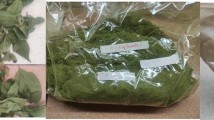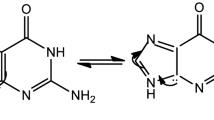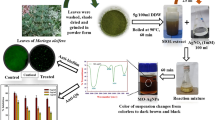Abstract
A series of Cu(II) , Ni(II) , Co(II) , Mn(II) and Zn(II) complexes have been synthesized from the Schiff base ligand L. The Schiff base ligand 4-chloro-2–((4-oxo-4H-chromen-3yl) methylene amino) benzoic acid (L) has been synthesized by the reaction between chromone-3-carbaldehyde and 4-chloro-2-amino benzoic acid. The nature of bonding and geometry of the transition metal complexes as well as ligand L have been deduced from elemental analysis, FT-IR, UV–vis, 1H NMR, 13C NMR, ESR spectral studies, mass, magnetic susceptibility and molar conductance measurements. The complexes are found to have ML2 composition and are neutral in DMSO. Based on elemental, conductance and spectral studies, six-coordinated geometry was assigned for these complexes. The ligand L acts as tridentate and coordinates through nitrogen atom of azomethine group, hydroxyl of the carboxyl group and oxygen atom of keto group of γ-pyrone ring. The interaction of Cu(II) complex with CT- DNA was carried out by UV–vis, fluorescence titrations and viscosity measurements. The complex binds to DNA through intercalative binding mode. The nuclease activity of the above metal complexes shows that Cu(II) and Co(II) complexes cleave DNA through redox chemistry. The biological activity of the ligand and its complexes have been studied on four bacteria E.coli, B.subtilis, pseudomonas and Edwardella and two fungi penicillium and trichoderma by well disc and fusion method and found that the metal complexes are more active than the free Schiff base ligand.






Similar content being viewed by others
References
Marcus Y, Eliezer I (1969) The stability of mixed complexes in solution. Coord Chem Rev 4:273–322
Eichoen GL (1973) Inorganic biochemistry. Elsevier, Amsterdam
Sigel H (1975) Ternary Cu2+ complexes: stability, structure and reactivity. Angew Chem Int Edit 1:394–402
Sigel H (1989) Metal ions in biological systems. Marecll Dekker, New York, pp 1–23
Kinjo Y, Ji L, Corfu NA, Sigel H (1992) Ambivalent metal ion binding properties of cytidine in aqueous solution. Inorg Chem 31:5588–5596
Frusto da Silva JJR,Williams RJP (1993) The Biological Chemistry of the Elements Clandreon: Oxford
Osz K, Varnagy K, Vargha HS, Csampay A, Sanna D, Micera G, Sovago I (2004) Acid–base properties and copper(II) complexes of dipeptides containing histidine and additional chelating bis(imidazol-2-yl) residues. J Inorg Biochem 98:24–32
Tainer JA, Getzoff DE, Richardson JS, Richardson DC (1983) Electrostatic recognition between superoxideand copper, zinc superoxide dismutase. Nature 306:287–289
Alves WA, Bagatin IA, Ferreria AMDC (2001) Equilibria and tyrosinase activity of a dinuclear and its analogous tetranuclear imidazolate-bridged copper(II) complexes Inorg. Chim Acta 321:11–21
Nagy NV, Planka TS, Rockenbauer A, Peintier G, Nagypal I, Korencz L (2003) Great structural variety of complexes in copper(II)-oligoglycine system: microspeciation and coordination modes as studied by the two dimentional simulation of electron paramagnetic resonance spectra. J Am Chem Soc 125:5227–5235
Liu WL, Zou Y, Ni CL, Ni ZP, Li YZ, Jin Q (2004) Crystal structure and spectroscopic properties of a new syn-anti carboxylate-bridged polymeric chain copper(II)-glycylglycine complex. J Coord Chem 8:657–664
Long LS, Yang SP, Chen XM, Tong YX, Ji LN (1999) synthesis, crystal structure and properties of copper(II) complexes of schiff base derivatives containing imidazole and β-alanine groups. J Chem Soc Dalton Trans 312:1999–2004
Nair MS, Sudhakumari S, Neelakanta MA (2007) studies on some novel Schiff base complexes in solution and solid state. J Coord Chem 60:1291–1302
Joseyphus RS, Dhanaraj CJ, Nair MS (2006) synthesis and characterization of some schiff base transition metal complexes derived from vanillin and L(+) alanine. Transit Met Chem 31:699–702
Sunitha M, Padmaja M, Anupama B, Gyana Kumari C (2012) Synthesis, characterization, DNA binding and cleavage studies of mixed-ligand Cu(II) complexes of 2,6-bis(benzimidazol-2-yl) pyridine. J Fluorescece 22:1003–1012
Prasanthi Y, Kiranmai K, Subhashini NJP, Shivaraj (2008) Synthesis, potentiometric and antimicrobial studies on metal complexes of isoxazole Schiff base. Spectrochimica Acta, Part A. 70:30–35
Hodnett EM, Mooney PD (1970) Antitumor activity of some schiff bases. J Med Chem 13:786
Hodnett EM, Dunn WJ (1972) Cobalt derivatives of some schiff bases of aliphatic amines as antitumor agents. J Med Chem 15:339
Sosnovskikh VY (2003) Synthesis and reactions of halogen-containing chromones. Russ Chem Rev 72:489–516
Singh G, Singh R, Giridhar GK, Ishar MPS (2002) Aversatile route to2-alkyl/aryl-amino-3-formyl-and hetero-annelated-chromones, through a facile nucleophilic substitution at C2 in 2-(N-methianilino)-3-formylchromones. Terahedron 58:2471–2480
Piao LZ, Park HR, Park YK, Lee SK, Park JH, Park MH (2002) Mushroom tyrosinase inhibition activity of some chromones. Chem Pharm Bull 50:309–311
Bharath Z, Radices R, Spengler G, Ocsovszki I, Kawase M, Motohashi N, Shirataki Y, Shah Y, Molnar J (2006) Multidrug resistance reversal by 3-formylchromones in human colon cancer and human mdr1 gene-transfected mouse lymphoma cells. In Vivo 20:645
Ishar MPS, Singh G, Singh S, Satyajit SK, Singh G (2006) Design, synthesis and evaluation of novel 6-chloro/fluoro chromone derivatives as potential topoisomerase inhibitor anticancer agents. Bioorg And Med Chem lett 16:1366–1370
Li Y, Yang ZY, Wu JC (2010) Synthesis, crystal structure, biological activities and fluorescence studies of transition metal complexes with 3-carbaldehyde chromone thiosemicarbazone. Eur J Med Chem 45:5692–5701
Walenzyk T, Carola C, Buchholz H, Konig B (2005) Chromone derivatives which bind to human hair. Terahedron 61:7366–7377
Arjunan V, Subramanian S, Mohan S (2004) FTIR and FTR spectral studies of 2-amino-6-bromo-3-formylchromone. Spectrochim Acta A 60:995–1000
Tharmaraj P, Kondimunthiri D, Sheela CD, Priya CJ (2009) Synthesis, spectral characterization and antimicrobial activity of copper(II), cobalt(II) and nickel(II) complexes of 3-formyl chromoniminopropyl silatrane. J Coord Chem 62:2220–2228
Magdy AI, El-Mahdy KM (2009) Synthesis and antimicrobial activities of some schiff bases derived from 2-amino-3-formylchromone. Phosphorous, Sulfur and Silicon 184:2945–2958
Ramakrishna Reddy K, Madhusudhan Reddy K, Mahendra KN (2006) Synthesis, characterization, antibacterial and anthelmentic activities of some benzofuran derivativesa. Indian J Chem 45A:377–381
Markod JT, Aswar AS (2004) Synthesis, characterization, biological and thermal properties of some new Schiff base complexes derived from 2-hydroxy-5-chloro-acetophenone and s-methyldithiocarbazate. Indian J Chem 43A:2120–2125
Conpolat E, Kaya M (2004) Studies on mononuclear chelates derived from substituted schiff base ligands (part 2): synthesis and characterization of a new 5-bromosalicyliden-p-aminoacetophenoneoxime and its complexes with Co(II), Ni(II), Cu(II) and Zn(II). J Coord Chem 57:1217–1223
Raman N, Ravichandran S, Thangarajan C (2004) Co(II), Ni(II), Cu(II) and Zn(II) complexes of schiff base derived from benzyl-2,4-dinitrophenylhydrazone with aniline. J Chem Sci 116:215–219
Lever ABP (1968) Electronic spectra of some metal complexes derivation of Dq and B. J Chem Edu 45:711–712
Ramam N, Kulandaisami A, Shunmugasundaram A, Jeyasubramanian K (2001) Synthesis, spectral, redox and antimicrobial activities of Schiff base complexes derived from 1-phenyl-2,4-dimethyl-4-aminopyrazol-5-one and acetoacetanilide. Trans Met Chem 26:131–135
Raman N, Raja YP, Kulandaisamy A (2001) Synthesis and characterisation of Mn(II), Ni(II), Cu(II), VO(II) and Zn(II) schiff base complexes derived from o-phenylenediamine and acetoacetanilide. J Chem Sci 113:183–189
Barton JK, Danishefsky A, Goldberg J (1984) Tris (phenanthroline)ruthenium(II): stereoselectivity in binding to DNA. J Am Chem Soc 106:2172–2176
Wolf A, Shimer GH Jr, Meehan T (1987) Polycyclic aromatic hydrocarbons physically intercalate into duplex regions of denatued DNA. Biochemistry 26:6392–6396
Baguley BC, Le Bret M (1984) Quenching of DNA-ethidium fluorescence by amsacrine and other antitumor agents: a possible electrone-transfer effect. Biochemistry 23:937–943
Lakowicz JR, Weber G (1973) Quenching of fluorescence by oxygen probe for structural fluctuations in macromolecules. Biochemistry 12:4161–4170
Sathyanarayana S, Dabrowiak JC, Chairs JB (1992) Neither delta nor lambda-tris(phenanthroline)ruthenium(II) binds to DNA by classical intercalation. Biochemistry 31:9319–9324
Author information
Authors and Affiliations
Corresponding author
Electronic supplementary material
Below is the link to the electronic supplementary material.
ESM 1
(DOCX 75 kb)
Rights and permissions
About this article
Cite this article
Mendu, P., Kumari, C.G. & Ragi, R. Synthesis, Characterization, DNA Binding, DNA Cleavage and Antimicrobial Studies of Schiff Base Ligand and its Metal Complexes. J Fluoresc 25, 369–378 (2015). https://doi.org/10.1007/s10895-015-1520-6
Received:
Accepted:
Published:
Issue Date:
DOI: https://doi.org/10.1007/s10895-015-1520-6




